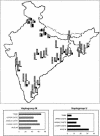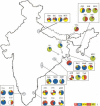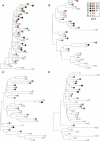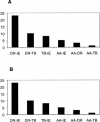Ethnic India: a genomic view, with special reference to peopling and structure
- PMID: 14525929
- PMCID: PMC403703
- DOI: 10.1101/gr.1413403
Ethnic India: a genomic view, with special reference to peopling and structure
Abstract
We report a comprehensive statistical analysis of data on 58 DNA markers (mitochondrial [mt], Y-chromosomal, and autosomal) and sequence data of the mtHVS1 from a large number of ethnically diverse populations of India. Our results provide genomic evidence that (1) there is an underlying unity of female lineages in India, indicating that the initial number of female settlers may have been small; (2) the tribal and the caste populations are highly differentiated; (3) the Austro-Asiatic tribals are the earliest settlers in India, providing support to one anthropological hypothesis while refuting some others; (4) a major wave of humans entered India through the northeast; (5) the Tibeto-Burman tribals share considerable genetic commonalities with the Austro-Asiatic tribals, supporting the hypothesis that they may have shared a common habitat in southern China, but the two groups of tribals can be differentiated on the basis of Y-chromosomal haplotypes; (6) the Dravidian tribals were possibly widespread throughout India before the arrival of the Indo-European-speaking nomads, but retreated to southern India to avoid dominance; (7) formation of populations by fission that resulted in founder and drift effects have left their imprints on the genetic structures of contemporary populations; (8) the upper castes show closer genetic affinities with Central Asian populations, although those of southern India are more distant than those of northern India; (9) historical gene flow into India has contributed to a considerable obliteration of genetic histories of contemporary populations so that there is at present no clear congruence of genetic and geographical or sociocultural affinities.
Figures









References
-
- Bamshad, M.J., Watkins, W.S., Dixon, M.E., Jorde, L.B., Rao, B.B., Naidu, J.M., Prasad, B.V.R., Rasanayagam, A., and Hammer, M.F. 1998. Female gene flow stratifies Hindu castes. Nature 395: 851-852. - PubMed
-
- Bandelt, H.J., Forster, P., and Rohl, A. 1999. Median-joining networks for inferring intraspecific phylogenies. Mol. Biol. Evol. 16: 37-48. - PubMed
-
- Beteille, A. 1998. The Indian heritage—A sociological perspective. In The Indian human heritage (eds. D. Balasubramian and N. Appaji Rao), pp. 87-94. University Press, Hyderabad, India.
-
- Bhattacharyya, N., Basu, P., Das, M., Pramanik, S., Banerjee, R., Roy, B., Roychoudhury, S., and Majumder, P.P. 1999. Negligible gene-flow across ethnic boundaries in India, revealed by analysis of Y-chromosomal DNA polymorphisms. Genome Res. 9: 711-719. - PubMed
WEB SITE REFERENCES
-
- http://alfred.med.yale.edu; ALFRED.
-
- http://gdbwww.gdb.org; GDB.
-
- http://lgb.unige.ch/arlequin/; ARLEQUIN.
-
- http://oat.bio.indiana.edu:7580/; DISPAN.
Publication types
MeSH terms
Substances
LinkOut - more resources
Full Text Sources
Research Materials
